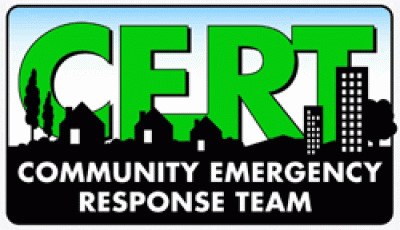C.E.R.T.
History
The Federal Emergency Management Agency, using the model created by the Los Angeles City Fire Department, began promoting nationwide use of the Community Emergency Response Team (CERT) concept in 1994. Since then, CERTs have been established in hundreds of communities.
CERT training promotes a partnering effort between emergency services and the people they serve. The goal is for emergency personnel to train members of neighborhoods, community organizations or workplaces in basic response skills. CERT members are then integrated into the emergency response capability for their area.
If a disastrous event overwhelms or delays the community's professional response, CERT members can assist others by applying the basic response and organizational skills they learned during training. These skills can help save and sustain lives following a disaster until help arrives. CERT skills also apply to daily emergencies.
CERT members maintain and refine their skills by participating in exercises and activities.They can attend supplemental training opportunities offered by the sponsoring agency and others that further their skills base. Finally, CERT members can volunteer for projects that improve community emergency preparedness.
Forest Park Fire and Emergency Services established its local C.E.R.T program in 2005. Since its conception members have assisted the Fire Department with a number of events and programs. Our C.E.R.T. is comprised of community residents and has become a valued part of our department.
CERT Training will teach participants to:
- Describe the types of hazards most likely to affect their homes and communities.
- Describe the function of CERT and their roles in immediate response.
- Take steps to prepare themselves for a disaster.
- Identify and reduce potential fire hazards in their homes and workplaces.
- Work as a team to apply basic fire suppression strategies, resources, and safety measures to extinguish a burning liquid.
- Apply techniques for opening airways, controlling bleeding, and treating shock.
- Conduct triage under simulated conditions.
- Perform head-to-toe assessments.
- Select and set up a treatment area.
- Employ basic treatments for various wounds.
- Identify planning and size-up requirements for potential search and rescue situations.
- Describe the most common techniques for searching a structure.
- Use safe techniques for debris removal and victim extrication.
- Describe ways to protect rescuers during search and rescue.
- Assist in Firefighter rehab. efforts on large-scale incidents.
Target Audience
- Neighborhoods
- Businesses
- Communities of Faith
- Scouting Organizations
- School Staff/Students
- Clubs/Organizations
- Amateur Radio Emergency Services
If you would like to become part of this team, please call (404) 608-2372 for additional information.

